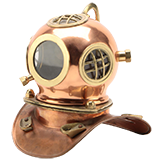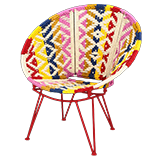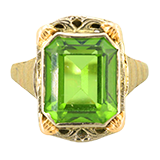Roy Lichtenstein Bronze Sculpture "Peace Through Chemistry Bronze"
Item Details
Bronze
Roy Lichtenstein (1923-1997)
Peace Through Chemistry Bronze, 1971
Bronze Multiple
Incised Signature, Numbered 18/38 to the lower right side
Published by Gemini G.E.L., Los Angeles, with their incised stamp
46.25’ W x 27.25’ H
Provenance:
Joan Sonnabend – Obelisk Gallery, Boston.
A Private Collection.
Literature:
Gemini, Publication Sequence Number 222
Roy Lichtenstein developed his signature Pop art style by merging high-art formalism with material culture. Although he had studied art from an early age, it was not until his late thirties that he began experimenting with cartoon images from comic books, advertisements, and other popular imagery. These works varied from abstract to figurative as he continued to develop his own visual vocabulary, for which he quickly became famous. Several key elements make a work by Lichtenstein instantly recognizable: blown up images taken either directly from or inspired by comic strips or newspaper ads; the use of primary colors; and ben-day dots, creating uniform color areas organized by definitive black outlines. It was important to Lichtenstein that the viewer not see evidence of gesture or the artist’s hand in his artistic process, although the seemingly mechanical style and lowbrow subject matter led some to dismiss his work; in 1964, Life published an article entitled “Is He the Worst Artist in the U.S.?” 1 Over time, it became easier to recognize that Lichtenstein’s imagery is both ironic and witty, and that his compositions were masterfully orchestrated.
Peace Through Chemistry was the first of four print and one bronze versions produced at Gemini G.E.L. in Los Angeles, California. Lichtenstein collaborated with master printmaker Kenneth Tyler, who supervised the production of all the editions. The artist created the original cardboard and clay maquette and collaborated directly with Gemini in the casting and hand-tooling of the plaster model. From this plaster model an aluminum casting was made and hand-finished to a smooth surface. This casting served as the mold maker’s pattern for the bronze sand castings. Each bronze casting was individually sandblasted and hand-chased. After a patina was hand-applied to the surface it was further treated with carbuba wax for protection.
Sources for the composition of Peace Through Chemistry can be found in Lichtenstein’s earlier series, Modern Painting, from 1967, in which the artist was inspired by Art Moderne motifs of the 1930s. The strong angularity of the composition is offset by the curvilinear lines of the microscope, gears, pulleys, and test tubes. The notches of the gears are echoed in the branching leaves and the fingers of the scientist holding a test tube from which a cloud of steam emanates. Stylized rays suggest sunlight and wings. In the right panel, the viewer perceives the geometric profile of a man, rendered as a comic book superhero holding a test tube. In the upper left of the center panel, another figure in profile examines the details of the leafy branch in the left panel through the eyepiece of a microscope.
The 1930s stylization, which Lichtenstein connected with the art commissions of the New Deal’s Works Progress Administration, seems especially appropriate to an apotheosis of science in its specific references to chemistry, biology, and engineering. Could the title be a not-so-subtle reference to the advertising slogan of DuPont, “Better Things for Better Living…Through Chemistry”? Or is the scientist examining a branch under his microscope a reference to an olive branch of peace? Lichtenstein saw the image as “muralesque… a little like the W.P.A. murals… a play on Cubist composition,” so perhaps irony was not his goal. In the end both artist and image retain their ambiguity. 2
Notes:
1 Life 56, no. 5 (January 31, 1964): 79–81, 83.
2 Ruth Fine, Gemini G.E. L.: Art and Collaboration. Exhibition catalogue. (New York: Abbeville Press, in association with the National Gallery of Art, 1984), 193.
At fourteen years of age, Roy Lichtenstein (1923–1997) was taking art classes at the Parsons School of Design in New York City and he enrolled in Saturday classes at the Art Students League, where his first class was with Reginald Marsh. Lichtenstein went on to Ohio State University, but his course of study was interrupted when he was drafted to serve in World War II. In 1946, he returned to the university to complete his Bachelor of Fine Arts, and, in 1949, he received his Master of Fine Arts. One of his instructors, Hoyt Sherman, had a distinctive teaching method for drawing based on psychological optics. The class met in the flash lab, a darkened space in which Sherman projected slides rapidly, and students had to draw based on their immediate recall of the images. Lichtenstein stayed on to teach at Ohio State University until 1951. When he was denied tenure, he and his wife, an interior designer, moved to Cleveland for her job. For the next six years, Lichtenstein made and exhibited art and worked various jobs, including commercial art and window displays for a department store.
In 1957, Lichtenstein got a teaching position at the State University of New York at Oswego, before moving on to Rutgers University, where he taught at Douglass College from 1960 to 1964. At Rutgers, Lichtenstein became friends with Allan Kaprow and, through him, met other artists including Claes Oldenburg and Jim Dine, who were involved with the first Happenings of the early 1960s. He got people’s attention by incorporating text and ben-day dots, a commercial printing process for adding shaded or tinted areas made up of dots. By the time of the seminal Pop art exhibition New Painting of Common Objects, held at the Pasadena Art Museum the following year, Lichtenstein had become one of the most recognized practitioners of the movement.
Roy Lichtenstein gained renown as a Pop artist when he was in his forties. While his early work was abstract and he owed a debt to Cubism, his trademark style relates to modernist formalism, particularly in his use of primary colors and patterned shapes. His subject matter is unmistakably American in its thematic and stylistic references to popular culture of the post-World War II era. Lichtenstein’s art was in tune with the 1960s, and he himself was quite at home with a new degree of visibility—a casual semi-celebrity—that was starting to be conferred upon certain up-and-coming artists. He is generally acknowledged as one of a handful of American artists that changed the direction of postwar art.
- Please note, this is an item that may be especially difficult to move and/or transport. Unless shipping arrangements are available and made by the winning bidder, that individual is advised to bring appropriate assistance, vehicle, proper materials, and any necessary tools to pickup.
Dimensions
Item #
17DCC300-906
Additional Information


























